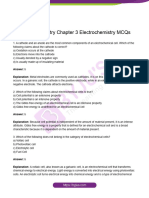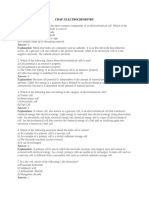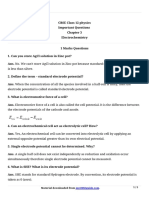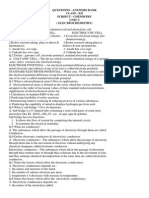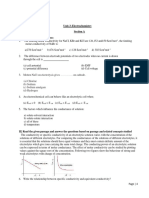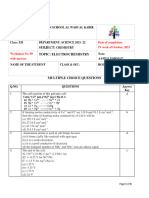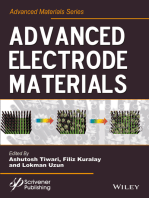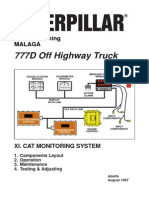0 ratings0% found this document useful (0 votes)
5 viewsElec Chem MCQ
Elec Chem MCQ
Uploaded by
dwijesh111256Copyright:
© All Rights Reserved
Available Formats
Download as DOCX, PDF, TXT or read online from Scribd
Elec Chem MCQ
Elec Chem MCQ
Uploaded by
dwijesh1112560 ratings0% found this document useful (0 votes)
5 views5 pagesOriginal Title
Elec chem mcq
Copyright
© © All Rights Reserved
Available Formats
DOCX, PDF, TXT or read online from Scribd
Share this document
Did you find this document useful?
Is this content inappropriate?
Copyright:
© All Rights Reserved
Available Formats
Download as DOCX, PDF, TXT or read online from Scribd
Download as docx, pdf, or txt
0 ratings0% found this document useful (0 votes)
5 views5 pagesElec Chem MCQ
Elec Chem MCQ
Uploaded by
dwijesh111256Copyright:
© All Rights Reserved
Available Formats
Download as DOCX, PDF, TXT or read online from Scribd
Download as docx, pdf, or txt
You are on page 1of 5
Class 12 Electrochemistry MCQs
1. A cathode and an anode are the most common components
of an electrochemical cell. Which of the following claims about
the cathode is correct?
a) Oxidation occurs at the cathode
b) Electrons move into the cathode
c) Usually denoted by a negative sign
d) Is usually made up of insulating material
Answer: b
Explanation: Metal electrodes are commonly used as
cathodes. It is on this electrode that reduction occurs. In a
galvanic cell, the cathode is the positive electrode, while in an
electrolytic cell, it is the negative electrode. The cathode
attracts electrons.
2. Which of the following claims about electrochemical cells is
true?
a) Cell potential is an extensive property
b) Cell potential is an intensive property
c) The Gibbs free energy of an electrochemical cell is an
intensive property
d) Gibbs free energy is undefined for an electrochemical cell
Answer: b
Explanation: Because cell potential is independent of the
amount of material present, it is an intense attribute. Gibbs free
energy is a property that is defined for an electrochemical cell
and is a broad characteristic because it is dependent on the
amount of material present.
3. Which of the following does not belong in the category of
electrochemical cells?
a) Voltaic cell
b) Photovoltaic cell
c) Electrolytic cell
d) Fuel Cell
Answer: b
Explanation: A voltaic cell, also known as a galvanic cell, is an
electrochemical cell that transforms chemical energy into
electrical energy. Light energy is converted into electrical
energy using photovoltaic cells. An electrolytic cell turns
electrical energy into chemical energy and is a type of
electrochemical cell. An electrochemical cell that converts the
chemical energy of a fuel and an oxidizing agent into electricity
is known as a fuel cell.
4. Which of the following assertions about the main cell is
correct?
a) An example of a primary cell is a mercury cell
b) An example of a primary cell is a nickel-cadmium storage
cell
c) The electrode reactions can be reversed
d) It can be recharged
Answer: a
Explanation: A primary cell is one in which the electrode
reactions only happen once and cannot be reversed with
electrical energy. As a result, primary cells are unable to be
recharged. A main cell, such as a mercury cell, is different from
a secondary cell, such as a nickel-cadmium storage cell.
5. In a dry cell, which of the following is the electrolyte?
a) Potassium hydroxide
b) Sulphuric acid
c) Ammonium chloride
d) Manganese dioxide
Answer: c
Explanation: In a dry cell, the electrolyte is ammonium
chloride, which is applied as a moist paste close to the zinc
anode. Ammonium chloride is replaced by sodium chloride in
some “heavy-duty” dry cells by zinc chloride.
6. Which of the following statements about a lead storage cell
(or a lead-acid battery) is false?
a) It is a primary cell
b) The cathode is made up of lead(IV) oxide
c) The anode is made up of lead
d) The electrolyte used is an aqueous solution of sulphuric acid
Answer: a
Explanation: A secondary cell with a grid of lead packed with
finely separated spongy lead for an anode and a grid of lead
packed with lead(IV) oxide for a cathode is known as a lead
storage cell. An aqueous solution of sulphuric acid is utilized as
the electrolytic solution in a lead-acid battery.
7. The conductivity of electrolytic conductors is due to
__________
a) Flow of free mobile electrons
b) Movement of ions
c) Either movement of electrons or ions
d) Cannot be said
Answer: b
Explanation: The flow of free mobile electrons causes
conductance in metallic conductors, while the movement of
ions in a fused electrolyte solution causes conductance in
electrolytic conductors.
8. The process of transmitting electric current through an
electrolyte’s solution to decompose it is known as __________
a) Electrolyte
b) Electrode
c) Electrolysis
d) Electrochemical cell
Answer: c
Explanation: Electrolysis is the decomposition of an electrolyte
by conducting an electric current through its solution.
9. In a fuel cell, which of the following can be utilized as a fuel?
a) Nitrogen
b) Argon
c) Hydrogen
d) Helium
Answer: c
Explanation: The simplest element is hydrogen. It’s also
widely available throughout the universe. Although hydrogen
has a lot of energy, an engine that runs on it produces nearly
no pollutants. As a result, it’s used in a fuel cell.
10. Which of the following is given to a fuel cell’s cathode?
a) Hydrogen
b) Nitrogen
c) Oxygen
d) Chlorine
Answer: c
Explanation: An anode, cathode, and electrolyte membrane
make up a fuel cell. In a normal fuel cell, hydrogen is passed
through the anode and oxygen is passed via the cathode.
You might also like
- Server Manual Siemens PDFDocument3 pagesServer Manual Siemens PDFmanuales tecnicos25% (8)
- Dynojet Power Commander V Fuel Ignition Yamaha Fz07Document8 pagesDynojet Power Commander V Fuel Ignition Yamaha Fz07Pedro CharruaNo ratings yet
- Updated Topic Coverage For Physics For The IB MYP 45 PDFDocument2 pagesUpdated Topic Coverage For Physics For The IB MYP 45 PDFVishnu Sharma67% (3)
- Chapter 3 ElectrochemistryDocument4 pagesChapter 3 ElectrochemistrykswoqpqqNo ratings yet
- MCQ On ElectrochemistryDocument8 pagesMCQ On Electrochemistrykashu7183No ratings yet
- ELECTROCHEMISTRYDocument4 pagesELECTROCHEMISTRYSAIRAJ PRABHAKAR PAWARNo ratings yet
- 12 Chemistry Imp Ch3 1Document5 pages12 Chemistry Imp Ch3 1Sneha saviousNo ratings yet
- GEN CHEM Q4 Module 6 PDFDocument17 pagesGEN CHEM Q4 Module 6 PDFAnthony CreationNo ratings yet
- Module 6 Gen Chem 2 q4Document17 pagesModule 6 Gen Chem 2 q4Hazel EncarnacionNo ratings yet
- M-CH-2-S-ENGDocument18 pagesM-CH-2-S-ENGrajeevkalota844No ratings yet
- MULTIPLE CHOICE. Choose The Best Answer. Underline/Encircle The Letter ofDocument3 pagesMULTIPLE CHOICE. Choose The Best Answer. Underline/Encircle The Letter ofReyy ArbolerasNo ratings yet
- Electrochemistry Question BankDocument11 pagesElectrochemistry Question Bankrranganath305No ratings yet
- XII Chemistry 7 ElectrochemistryDocument6 pagesXII Chemistry 7 Electrochemistryrajnihemant96No ratings yet
- ElectrochemistryDocument6 pagesElectrochemistrygangasinghnayal20No ratings yet
- Questions - Answers Bank Class - Xii Subject - Chemistry UNIT-3 (Electrochemistry)Document6 pagesQuestions - Answers Bank Class - Xii Subject - Chemistry UNIT-3 (Electrochemistry)Abhay BharadwajNo ratings yet
- Electrochemistry AssignmentDocument4 pagesElectrochemistry AssignmentIMMORTAL GAMERNo ratings yet
- Applied Chemistry Module IV Q&Ans Part 2Document11 pagesApplied Chemistry Module IV Q&Ans Part 2kannankarthi3002No ratings yet
- Electrochemitry FinalDocument29 pagesElectrochemitry FinalGGEZNo ratings yet
- ELECTROCHEMISTRY mcqsDocument5 pagesELECTROCHEMISTRY mcqskartikyadav2655No ratings yet
- Ch.2 Electrochemistry MCQ and ARDocument20 pagesCh.2 Electrochemistry MCQ and ARkrish846800No ratings yet
- Electrochemistry NotesDocument13 pagesElectrochemistry Notesaryantechs1365No ratings yet
- Ncert Exemplar ElectrochemistryDocument26 pagesNcert Exemplar Electrochemistryanshuman18530No ratings yet
- ElectrolysisDocument13 pagesElectrolysisNagaNo ratings yet
- Class X ElectrolysisDocument4 pagesClass X ElectrolysisvartikasinghNo ratings yet
- 11 - ElectrochemistryDocument6 pages11 - Electrochemistryhumaaot7No ratings yet
- Special Class Electro Chemistry 23Document19 pagesSpecial Class Electro Chemistry 23sheetal10swetaNo ratings yet
- Cbse Test Paper-02 Class 12 Chemistry (Electrochemistry)Document8 pagesCbse Test Paper-02 Class 12 Chemistry (Electrochemistry)pridey2020No ratings yet
- ElectrochemistryDocument3 pagesElectrochemistryjainaba mohamedNo ratings yet
- E°cell Is The Standard Cell Potential.: Chem 1E Quiz 1 Part BDocument2 pagesE°cell Is The Standard Cell Potential.: Chem 1E Quiz 1 Part Breynolds numberNo ratings yet
- WS4,5,6,7 WK 16-20 Aug Energy and Chemicals Class 10 ZoyaDocument18 pagesWS4,5,6,7 WK 16-20 Aug Energy and Chemicals Class 10 ZoyaUsman AsmatullahNo ratings yet
- 8467048-Class 12 - Chemistry-Electrochemistry-Ws With Ans. - JeniferDocument8 pages8467048-Class 12 - Chemistry-Electrochemistry-Ws With Ans. - Jeniferratankale0401No ratings yet
- ElectrochemistryDocument6 pagesElectrochemistrytwinkleparmar0064No ratings yet
- ElectrochemistryDocument2 pagesElectrochemistrydeetchu10No ratings yet
- Chemistry Test - Chapter 1Document4 pagesChemistry Test - Chapter 1ameena-11173No ratings yet
- PovertyDocument30 pagesPovertyeyasusolomon56No ratings yet
- Chemical Effects Revision WorksheetDocument4 pagesChemical Effects Revision WorksheetAbhyuday SwamiNo ratings yet
- Class 12 Important Questions For Chemistry - Electrochemistry PDFDocument12 pagesClass 12 Important Questions For Chemistry - Electrochemistry PDFphilip karimNo ratings yet
- Class 12 Electrochemistry QuestionsDocument4 pagesClass 12 Electrochemistry QuestionsShifaNo ratings yet
- ElectrochemistryDocument2 pagesElectrochemistryuntraceable2023censorNo ratings yet
- Class 12 Chemistry Vba For A ChapterDocument43 pagesClass 12 Chemistry Vba For A ChapterGaneshNo ratings yet
- CBSE Class 12 Chemistry Electrochemistry Questions AnswersDocument14 pagesCBSE Class 12 Chemistry Electrochemistry Questions AnswersDivyansh Rana100% (1)
- Chapter 10 Electrochemistry Text Book ExerciseDocument31 pagesChapter 10 Electrochemistry Text Book ExerciseshahidkakaNo ratings yet
- Lab Report 2 CELLDocument6 pagesLab Report 2 CELLNur Arina Dayana33% (3)
- Questions in Fuel and BatteriesDocument20 pagesQuestions in Fuel and BatteriesMahendra Nathan100% (1)
- PU12 Chemistry Question Bank - Electrochemistry: Ω M Si Ohm Cm CGSDocument15 pagesPU12 Chemistry Question Bank - Electrochemistry: Ω M Si Ohm Cm CGSAnaghesh MuruliNo ratings yet
- MSR Sir'sDocument12 pagesMSR Sir'sappuschizoid19No ratings yet
- Solid StateDocument219 pagesSolid StateBrimstoneNo ratings yet
- Chemical Effect of Electric Current-5 (2021-22)Document24 pagesChemical Effect of Electric Current-5 (2021-22)Avyam SharmaNo ratings yet
- Worksheet # 1 Class: 8 Prepared By: FURQAN JAMEELDocument5 pagesWorksheet # 1 Class: 8 Prepared By: FURQAN JAMEELnainajamNo ratings yet
- Voltage SourcesDocument8 pagesVoltage SourcesRizqa Gusti NarawitaNo ratings yet
- 3.CBQ ElctrochemDocument7 pages3.CBQ Elctrochemincredibleman653No ratings yet
- Q4 STEM General Chemistry 2 Week 6Document4 pagesQ4 STEM General Chemistry 2 Week 6ericaNo ratings yet
- Chap 17 SGDocument2 pagesChap 17 SG027marble9zNo ratings yet
- Basic of Biomedical Instruments Mcqs (Set-1) : Chapter: Bio Potential and Electrodes TypesDocument8 pagesBasic of Biomedical Instruments Mcqs (Set-1) : Chapter: Bio Potential and Electrodes TypesdeborahNo ratings yet
- Concept of ElectrochemitryDocument15 pagesConcept of ElectrochemitryKritika SainiNo ratings yet
- Electrochem Mock TestDocument3 pagesElectrochem Mock Testleafyfun100No ratings yet
- Electrochemical Cells: Estido - Fabros - Funtalva - Golondrina - Hipolito - LampaDocument46 pagesElectrochemical Cells: Estido - Fabros - Funtalva - Golondrina - Hipolito - LampaPaoleneNo ratings yet
- IMP ElectrochemistryDocument5 pagesIMP ElectrochemistryShan PanwarNo ratings yet
- Commercial CellsDocument4 pagesCommercial Cellsmayankdawar8756No ratings yet
- Electrochemistry (1 and 2 Marks QS)Document5 pagesElectrochemistry (1 and 2 Marks QS)Waibhav KumarNo ratings yet
- Sustainable and Green Electrochemical Science and TechnologyFrom EverandSustainable and Green Electrochemical Science and TechnologyNo ratings yet
- Principles of Solar Cells, LEDs and Related Devices: The Role of the PN JunctionFrom EverandPrinciples of Solar Cells, LEDs and Related Devices: The Role of the PN JunctionNo ratings yet
- Android Smart Phone Based Voice To Text Wireless Electronic Notice Board.Document4 pagesAndroid Smart Phone Based Voice To Text Wireless Electronic Notice Board.dileeppatraNo ratings yet
- Electric Diagram: E-GMAX-V3 EBROY01003-EBROY01004-EBROY01005 Electric Diagram Granulator 1 Motor High SpeedDocument15 pagesElectric Diagram: E-GMAX-V3 EBROY01003-EBROY01004-EBROY01005 Electric Diagram Granulator 1 Motor High Speedahmed.farahat00No ratings yet
- Atmega32 and Graphical LCD Based Portable OscilloscopeDocument9 pagesAtmega32 and Graphical LCD Based Portable OscilloscopebhvallabhaneniNo ratings yet
- Vmo 50HZ PDFDocument1 pageVmo 50HZ PDFСаво ЂокићNo ratings yet
- Philips Semiconductors Linear ProductsDocument5 pagesPhilips Semiconductors Linear Productsfalcon_developmentNo ratings yet
- Examination of Heavy Wall Pressure Vessel WeldsDocument8 pagesExamination of Heavy Wall Pressure Vessel WeldsDurgamadhaba Mishra100% (2)
- Automation For The Belt Conveyor System - Formatted PaperDocument6 pagesAutomation For The Belt Conveyor System - Formatted PaperYOLANDA SILVA ESCAMILLANo ratings yet
- Compactlogix P1Document20 pagesCompactlogix P1eumetallicaNo ratings yet
- p0335 Nissan Sentra 2003 2.5Document7 pagesp0335 Nissan Sentra 2003 2.5DirciosNo ratings yet
- Fast Bus Transfer Systems: A System Solution Approach: Aartech Solonics LTD., Bhopal, IndiaDocument38 pagesFast Bus Transfer Systems: A System Solution Approach: Aartech Solonics LTD., Bhopal, IndiaDurga PrasadNo ratings yet
- Assembly Features: Front ViewDocument4 pagesAssembly Features: Front ViewTaQuangDucNo ratings yet
- Experiment 3Document6 pagesExperiment 3Mulalo Tharaga MulaudziNo ratings yet
- Techson Brochure SEP NEWDocument15 pagesTechson Brochure SEP NEWKamal SharmaNo ratings yet
- Aruba AP93Document4 pagesAruba AP93Haseeb hasiNo ratings yet
- GuitarDocument21 pagesGuitarkindergarten111100% (1)
- Bett Cummins EntrenamientoDocument5 pagesBett Cummins Entrenamientoacere18No ratings yet
- Laboratory #6: Dipole and Monopole Antenna Design: I. ObjectivesDocument6 pagesLaboratory #6: Dipole and Monopole Antenna Design: I. ObjectivesArindam Banerjee100% (1)
- Syncronous Machine TUTDocument6 pagesSyncronous Machine TUTClaudioNo ratings yet
- Praesideo 4.0 - Instaln & User InstrDocument488 pagesPraesideo 4.0 - Instaln & User InstrredvalorNo ratings yet
- 370HR Laminate and Prepreg Data Sheet IsolaDocument2 pages370HR Laminate and Prepreg Data Sheet Isolasathi420No ratings yet
- 777D Off Highway Truck: Service Training MalagaDocument16 pages777D Off Highway Truck: Service Training MalagaEvan AT Yoel100% (1)
- 400kv Substation Training ReportDocument31 pages400kv Substation Training ReportShailendra Yadav85% (26)
- 7 Electrical Load Study: 7.1 TerminologyDocument2 pages7 Electrical Load Study: 7.1 TerminologyReneNo ratings yet
- Witricity SeminarDocument30 pagesWitricity SeminarYadhu KrishnanNo ratings yet
- Ijeet: International Journal of Electrical Engineering & Technology (Ijeet)Document15 pagesIjeet: International Journal of Electrical Engineering & Technology (Ijeet)IAEME PublicationNo ratings yet
- Brochure CTS-9005Document4 pagesBrochure CTS-9005Dika AnggaraNo ratings yet
- Switchgear Training Calendar Fy 2019 20 10 PDFDocument18 pagesSwitchgear Training Calendar Fy 2019 20 10 PDFdeepu kumarNo ratings yet



